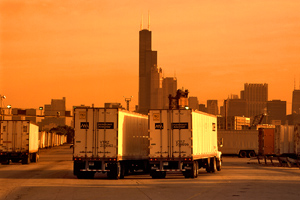Chicago Planning Agency Proposes Freight Fund for Infrastructure

The Chicago Metropolitan Agency for Planning unveiled a report that suggests creating a special metropolitan freight fund to pay for freight-related infrastructure improvements.
The report is the result of an eight-month study by a freight task force that CMAP formed in October to advise the agency on how to tackle freight congestion problems.
“This fund should be supported by existing and/or new revenue sources raised from users of the regional freight system,” the 22-page report said.
Among the possible sources of revenue for the fund are current or “enhanced” truck-registration fees, existing or higher diesel taxes, a tax on vehicle miles traveled, taxes on alternative fuels or a ton-miles tax, sometimes called a weight-distance tax, said the report released June 12 by CMAP.
The report did not put tolling on its list of possible revenue sources for the freight fund nor did the task force take a formal position on tolling.
However, in a long segment within the report tolling was touted as a revenue method that could support the whole transportation system as well as freight mobility.
“The Task Force believes that tolling merits particular discussion,” the task force said. “Tolls represent a direct user fee: only those who use the tolled facility pay for its capital, operation, and maintenance costs.
“Further, tolling is immune to the weaknesses of other transportation revenue sources . . . and, if indexed to inflation, could be a reliable revenue source in the long term.”
By contrast, fuel tax revenues are already dwindling as vehicles become more fuel efficient and a VMT would require technology not yet available, the task force report said.
The report pointed out that the Chicago region already has experience with tolling, on the Illinois Tollway, and said tolling just 25% of the expressway system in northeastern Illinois could generate $352 million in 2015.
Some of the new revenue from tolling could be used to maintain the expressways and a portion could be dedicated to the freight fund run by CMAP, the report said.
One task force member, Rick Dickens, owner of Cannonball Express Line in Montgomery, Ill., credited the group with hard work but said he’s unsure the report will generate any action.
“I don’t know, to be honest with you, where it’s going to go,” Dickens said. “In my opinion there’s just a lot of things in there that are not going to fly.”
Tolling cars to help pay for freight may not be a realistic proposition, Dickens said, adding that there have also been other studies by other groups and none has relieved the region’s congestion problems.
“Back when I was young, basically, you had a commute rush hour and in Chicago, it’s all day now,” he said.
According to the task force report, a billion tons of freight worth over $3 trillion moves through the Chicago region each year.
And the American Transportation Research Institute has pinpointed the Chicago region as having some of the worst freight bottlenecks in the country.
Don Schaffer, executive vice president of the Mid-West Truckers Association headquartered in Illinois, was also skeptical about what impact the CMAP report would have.
“I think it reiterates a lot of what has been said . . . but it also reaffirms that no one’s in agreement on how to handle these issues,” Schaffer said.
He said that the trucking industry, for example, is cool to tolling and asked how transportation planners could even consider collecting a VMT when trucks running through the area come from all over the country.
As for higher truck fees to generate revenue for a freight fund, he said that Illinois already has some of the highest truck fees in the country.
One of the things the region is grappling with, he said, is the explosion of the intermodal business, thanks to the many railroad lines that were built more than a century ago around the city.
“There’s like 30 intermodal yards peppered all over Chicago,” he said.
The freight task force was created in response to a recommendation for it in CMAP’s comprehensive regional plan, named GO TO 2040, which was adopted in October 2010, said CMAP Communications Director Tom Garritano.
“The report is advisory to CMAP and other units of government in our region and state,” Garritano said.
Now that the report is public, it will be sent to a broad set of partners in the various sectors involved that include government, rail, trucking and other business leaders, he said.

